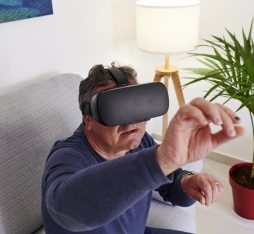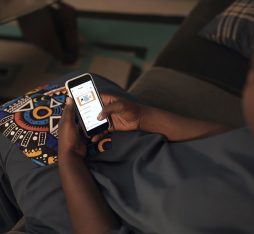
Although[1] digital technologies can be used therapeutically in the field of addiction medicine[2], they can also be pathologised through the prism of addiction. The concept of Internet addiction was introduced by those affected, but it became a topic of clinical interest in the mid-1990s. It remains a controversial psychiatric entity and in France it is the subject of a government initiative aimed at supporting .
Definition of Internet addiction
Internet addiction refers to a pathological loss of control, which is medically diagnosed and can be treated. The notion of , then, is chiefly used to refer to the difficulties encountered in managing one’s use of digital tools more broadly.
Different characterisations of this public problem identify, with varying degrees of specificity, the technology (digital technology, screens, smartphones, Internet etc.), types of activities (social networks, cybersex, online games etc.) and degree of pathologisation (ranging from problematic uses to addiction) involved. Having not yet been properly examined, the development of generative AI could also change the game and exacerbate the problem.
Most people consider their use of digital technology to be problematic.
The literature highlights the lack of reliable epidemiological data on . A recent meta-analysis estimates a prevalence rate of 7.02% in the general population (Pan et al., 2020). While this figure challenges the notion that we could all be addicted, the fact remains that the majority of people consider their use of digital technology to be problematic (Boudard et al., 2022). In light of the current WHO paradigm that understands mental health not only as the absence of psychiatric illness, but more broadly as a state of mental well-being, this makes it a public health issue.
Problematic uses are characterised in terms of time spent[3], difficulty in disconnecting[4] and a thwarted intentionality[5]. The repercussions of this can be seen in the areas of development (especially in terms of language), attention (cognitive overload, agitation, memory problems), mental health (anxiety, depression, eating disorders, suicidal thoughts) and physical health (diet, sedentary lifestyle, sleep, posture, eyesight). Warning signs of high-risk behaviour are linked to social, behavioural or emotional breakdown (dropping out of school, loss of interest in an activity normally enjoyed, a withdrawal from friends etc.).
Persuasive design
The difficulty in managing our use of digital technology could be considered a matter of individual responsibility, but it’s also possible to blame the designers. Big Tech companies are now understood to be positioning themselves in an “attention economy”[6]: They strengthen their market power by increasing their ability to make users spend time on their products.
It is customary for Big Tech designers to draw on the work of the Behavior Design Lab (Stanford University) to design “persuasive” technologies[7]. The director of this laboratory, BJ. Fogg, is the man behind a field of research dedicated to this issue, “ ”, the study of computers and digital technologies as tools of influence[8].
Persuasive design can be defined as a digital design method that draws on elements of behavioural social psychology to influence users’ opinions and behaviours.
With this in mind, several features have been designed to attract and retain users’ attention: infinite scrolling (so users lose the notion of time), autoplay of videos, random rewards (such as comments) and social validation (the “like”)[9].
This method has come under criticism in the context of the movement led by the “Silicon Valley repenters”[10]. These criticisms have been shared with the general public in the media[11].
From a successful popular concept…
Several socio-historical works have studied various corpora (general press, specialised literature, online discussion forums etc.) to chart the construction of Internet addiction as a public problem (Juneau & Martel, 2014; Bueno, 2014). They highlight that lay discourse (i.e. people, especially journalists, claiming for themselves that their use of digital tools was pathological[12]) predated expert discourse (in terms of scientific research).
Internet addiction therefore established itself as a popular classification before it became a scientific one. This is evidenced by the very birth of the concept in 1994. American psychiatrist Ivan K. Goldberg’s satirical proposal to diagnose “Internet addiction disorder” in a peer-to-peer discussion forum provoked so many reactions of self-diagnosis and requests for help that he followed up by creating an online support group, the “Internet Addiction Support Group”.
To a clinical research issue
Clinical interest in Internet addiction dates back to the mid-1990s. Research first centred around the pathologisation of new leisure, social interaction and sexual practices brought about by computers, with other concepts such as “ ” (obsessive searching for information online) and “compulsive buying” later appearing in psychology textbooks (Hautefeuille & Véléa, 2010). Research on excessive consumption of pornography marked the beginning of the application of clinical medicine to online practices (Vörös, 2009).
Psychologist Kimberly Young then took inspiration from the category of “pathological gambling”, recognised in the DSM-IV of the American Psychiatric Association and in the ICD-11 (International Classification of Diseases) of the WHO, to propose the first definition of Internet addiction in 1996, a new illness related to “impulse control disorders”, as well as an Internet addiction test (20 items that give a total score of 0 to 100)[13].
Scientific debate
The research into Internet addiction that then emerged varied widely in theme and approach. First, studies focused either on the Internet or on the use of offline digital tools (Vaugeois, 2006).
Among the research into forms of online addiction, a first branch focused on addictions (gambling, sex etc.) that played out on the Internet, with this tool ultimately being nothing more than a new location for such practices (Billieux, 2012).
A second branch was more directly interested in Internet addiction (Griffiths et al., 2014), involving the characteristics of the “product” (for example, in the form of the 3 A’s model: accessible, anonymous, affordable).
A third branch, in line with the work of John Grohol (1999), one of the pioneers of “ [14]”, focused on the “compensatory use” of the Internet (Kardefelt-Winther, 2014). Digital technology is understood as a means for individuals to overcome their problems in “real life”. Cyberdependence is therefore a symptom rather than a disorder in its own right.
Internet addiction remains a controversial psychiatric entity. The inclusion of Internet addiction in the 5th version of the American Psychiatric Association’s Diagnostic and Statistical Manual of Mental Disorders (DSM-V) was discussed on the recommendation made by Jerald J. Block in an editorial for The American Journal of Psychiatry in 2008. This recommendation was based on the identification of four symptoms: excessive use of the Internet, withdrawal, tolerance and negative repercussions on social life.
In the end, only Internet gaming addiction was included in the manual in 2013, due to a lack of neurobiological evidence as well as clinical studies on behavioural criteria such as withdrawal or relapse (Fourquet-Courbet & Courbet, 2017).
Supporting digital parenting
In France, the government’s concern for “the psychosocial risks associated with excessive and early practices of gaming, Internet use, and the length of time spent in front of screens” appears in the government plan to combat drugs and addictive behaviour (2013–2017), in a structured statement about pathological gambling.
This statement is expanded in the French National plan for mobilisation against addictions (2018–2022) and concentrates above all on parents who lack points of reference in the face of their children’s problematic use.
Government action is currently centred around three issues[15]: “encouraging research into the risks associated with excessive screen use”[16], “better informing the general public about good screen use” through awareness campaigns focused on supporting “digital parenting”[17], and “facilitating the identification of warning signs and guidance towards support and counselling structures” related to social work, child psychiatry and addiction studies (maternal and child protection, medico-psychological centres, Maisons des adolescents [youth-friendly facilities], Consultations jeunes consommateurs [support for young users] etc.).
Toward standards of good practice?
In this period where many critics tend to even question the benefits of digitising activities (Alexandre et al., 2022), we are witnessing a movement towards “responsible” and “ethical” innovation from designers, alongside a trend towards user empowerment.
Measures and tools that promote controlled use of digital technology are multiplying, including “digital detox” getaways, an abundance of practical advice[18], development of smartphone features (weekly screen time report, “focus” mode, “screen time limit” configuration etc.) and marketing of dedicated applications (parental control[19] and self-regulation[20]).
As part of a preventive approach, this development seems to invite public authorities to set and disseminate standards of good practice for digital technology use (time slots, age groups etc.), much like they have done for food.
Orange’s commitment
This assessment of the current situation served as the basis for a dedicated module on raising awareness of Internet addiction in the digital workshops led by Orange Solidarité, which are aimed at young people entering the job market and vulnerable women.
With regard to support for digital parenting, social sciences can help to nurture Orange’s commitment by shedding light on why parents consider some of their children’s use of digital technology to be problematic and how to support them in their attempts (with varying degrees of self-confidence, happiness and satisfaction) to regulate these practices.
More generally, the use of sociological surveys on the problematisation of the use of digital technology can help the digital ecosystem to anticipate changes in devices used and access to content by children and teenagers.
[1] Based on the French title (“Tous accros à l’écran”) of an episode of La méthode scientifique (The scientific method) on France Culture, broadcast on 14 February, 2018
[2] See the article “How virtual reality can improve addiction treatment” published on Hello Future.
[3] On average, we spend one third of our waking hours in front of a screen (French Digital Barometer 2022).
[4] More than one in two people said that they could not be without Internet for more than a day without missing it (French Digital Barometer 2022).
[5] More than eight out of ten respondents spend more time than they think on screens (MILDECA [Mission interministérielle de lutte contre les drogues et les conduites addictives — French Inter-ministerial Mission for Combating Drugs and Addictive Behaviours] barometer on screen uses and related issues, 2021).
[6] 2022 report of the French National Digital Council: Votre attention, s’il vous plait ! Quels leviers face à l’économie de l’attention ? (Your attention, please! What can we do to tackle the attention economy?)
[7] See the example of the “Facebook class” in 2007: “The Class That Built Apps, and Fortunes”
[8] Fogg, BJ., 2003, Persuasive Technology: Using Computers to Change What We Think and Do. Morgan Kaufmann Publishers.
[9] See Tristan Harris’s article, “Comment la technologie pirate l’esprit des gens” (“How technology is hacking people’s minds”)
[10] L’usine digitale : “Tristan Harris, Sean Parker, Renée DiResta… Qui sont les repentis de la Silicon Valley ?” (L’usine digitale: “Tristan Harris, Sean Parker, Renée DiResta… Who are the Silicon Valley repenters?”)
[11] See for example the documentary on social media The Social Dilemma
[12] For French examples of this, see the accounts of Thierry Crouzet (2012) and Guy Birenbaum (2015).
[13]Internet Addiction Test Manual
[14] Cyberpsychology is an interdisciplinary scientific field that aims to understand the psychological processes emerging as a result of human interactions with digital technologies.
[15] “L’Essentiel sur… les usages problématiques d’écrans” (“The essentials on problematic screen use”)
[16] See the creation of the committee of experts on “the impact of children’s exposure to screens” by Emmanuel Macron in January 2024.
[17] See the jeprotegemonenfant.gouv.fr platform (a French platform for digital parenting) launched in 2021.
[18] See, for example, the “Take Control Toolkit” of the Center for Humane Technology founded by Tristan Harris: https://www.humanetech.com/take-control
[19] https://www.leptidigital.fr/technologie/applications-controle-parental-42805/
[20] https://www.lemonde.fr/pixels/article/2019/03/01/quatre-applications-pour-reprendre-la-main-sur-son-smartphone_5429740_4408996.html
On average, we spend one third of our waking hours in front of a screen (French Digital Barometer 2022).
Sources :
Bibliography
Alexandre O. et al., 2022, “A sociohistory of digital critique”, Réseaux, 231(1), 9–37.
Block J. J., 2008, “Issues for DSM-V: Internet Addiction”, Am J Psychiatry, 165(3), 306–307.
Boudard M. et al., 2022, “Item Response Theory Analyses of Diagnostic and Statistical Manual of Mental Disorders, Fifth Edition (DSM-5) Criteria Adapted to Screen Use Disorder”, JMIR, 24(7).
Billieux J., 2012, “Problematic Use of the Mobile Phone”, Current Psychiatry Reviews, 8(4), 299–307.
Bueno V., 2014, “Inclure l’addiction à Internet dans le DSM-V” (“Include Internet addiction in DSM-V”), Sociology Master thesis, Université de Montréal.
Fourquet-Courbet M-P., Courbet D., 2017, “Anxiété, dépression et addiction liées à la communication numérique” (“Anxiety, depression and addiction related to digital communication”), RFSIC, 11.
Griffiths M. et al., 2014, “Social Networking Addiction: An Overview of Preliminary Findings”, In Rosenberg K., Feder L. (eds.), Behavioral Addictions, New York, Elsevier, 119–141.
Grohol JM., 1999, “Too much time online: internet addiction or healthy social interactions?”, Cyberpsychol. Behav. Soc. Netw. 2(5), 395–401.
Hautefeuille M., Véléa D., 2010, Les addictions à Internet: De l’ennui à la dépendance (Internet addiction: From boredom to dependence), Paris, Payot.
Juneau S., Martel J., 2014, ““Cyberdependence”: A Phenomenon under Construction”, Déviance & Société, 38(3), 285–310.
Kardefelt-Winther D., 2014, “A conceptual and methodological critique of internet addiction research: Towards a model of compensatory internet use”, Comp Hum Behav, 31, 351–354.
Pan YC. et al., 2020, “Systematic review and meta-analysis of epidemiology of internet addiction”, Neurosci Biobehav Rev, 118, 612–622.
Pedersen L., 2019, Expertises et addictions (Expertise and addictions), Paris, L’Harmattan.
Vaugeois P., 2006, “La cyberdépendance : fondements et perspectives” (“Cyberdependence: Foundations and perspectives”), CQLD, Montréal.
Vörös F., 2009, “The invention of addiction to pornography”, Sexologies, 18(4), 270–276.
All the actions undertaken by parents to guide and supervise their children’s use of digital technologies.
A pathological loss of control of use of digital technology, which is medically diagnosed and can be treated.
An interdisciplinary scientific field that aims to understand the psychological processes emerging as a result of human interactions with digital technologies.











